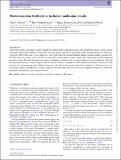Files in this item
Photoionization feedback in turbulent molecular clouds
Item metadata
| dc.contributor.author | Sartorio, Nina S. | |
| dc.contributor.author | Vandenbroucke, Bert | |
| dc.contributor.author | Falceta-Goncalves, Diego | |
| dc.contributor.author | Wood, Kenneth | |
| dc.date.accessioned | 2021-01-05T17:30:01Z | |
| dc.date.available | 2021-01-05T17:30:01Z | |
| dc.date.issued | 2021-01 | |
| dc.identifier | 271800374 | |
| dc.identifier | 1823b1cf-8ebb-4b80-bcec-db02f489f866 | |
| dc.identifier | 85097510902 | |
| dc.identifier | 000605983000021 | |
| dc.identifier.citation | Sartorio , N S , Vandenbroucke , B , Falceta-Goncalves , D & Wood , K 2021 , ' Photoionization feedback in turbulent molecular clouds ' , Monthly Notices of the Royal Astronomical Society , vol. 500 , no. 2 , pp. 1833-1843 . https://doi.org/10.1093/mnras/staa3380 | en |
| dc.identifier.issn | 0035-8711 | |
| dc.identifier.uri | https://hdl.handle.net/10023/21223 | |
| dc.description | NS acknowledges funding from the Royal Society University Research Fellowship of Anastasia Fialkov and the CAPES funding agency for financial support during her PhD. BV acknowledges funding from the Belgian Science Policy Office (BELSPO) through the PRODEX project ‘SPICA-SKIRT: A far-infrared photometry and polarimetry simulation toolbox in preparation of the SPICA mission’ (C4000128500). KW and BV acknowledge support by STFC grant no. ST/M001296/1. The equipment was funded by BEIS capital funding via STFC capital grants ST/K000373/1 and ST/R002363/1 and STFC DiRAC Operations grant ST/R001014/1. DiRAC is part of the National e-Infrastructure. | en |
| dc.description.abstract | We present a study of the impact of photoionization feedback from young massive stars on the turbulent statistics of star-forming molecular clouds. This feedback is expected to alter the density structure of molecular clouds and affect future star formation. Using the AMUN-Rad code, we first generate a converged isothermal forced turbulent density structure inside a periodic box. We then insert an ionizing source in this box and inject photoionization energy using a two-temperature pseudo-isothermal equation of state. We study the impact of sources at different locations in the box and of different source luminosities. We find that photoionization has a minor impact on the 2D and 3D statistics of turbulence when turbulence continues to be driven in the presence of a photoionizing source. Photoionization is only able to disrupt the cloud if the turbulence is allowed to decay. In the former scenario, the presence of an H ii region inside our model cloud does not lead to a significant impact on observable quantities, independent of the source parameters. | |
| dc.format.extent | 11 | |
| dc.format.extent | 2556581 | |
| dc.language.iso | eng | |
| dc.relation.ispartof | Monthly Notices of the Royal Astronomical Society | en |
| dc.subject | H ii regions | en |
| dc.subject | Methods: numerical | en |
| dc.subject | Radiative transfer | en |
| dc.subject | Turbulence | en |
| dc.subject | QB Astronomy | en |
| dc.subject | QC Physics | en |
| dc.subject | Space and Planetary Science | en |
| dc.subject | Astronomy and Astrophysics | en |
| dc.subject | NDAS | en |
| dc.subject.lcc | QB | en |
| dc.subject.lcc | QC | en |
| dc.title | Photoionization feedback in turbulent molecular clouds | en |
| dc.type | Journal article | en |
| dc.contributor.sponsor | Science & Technology Facilities Council | en |
| dc.contributor.institution | University of St Andrews. School of Physics and Astronomy | en |
| dc.contributor.institution | University of St Andrews. Centre for Biophotonics | en |
| dc.identifier.doi | https://doi.org/10.1093/mnras/staa3380 | |
| dc.description.status | Peer reviewed | en |
| dc.identifier.grantnumber | ST/M001296/1 | en |
This item appears in the following Collection(s)
Items in the St Andrews Research Repository are protected by copyright, with all rights reserved, unless otherwise indicated.

